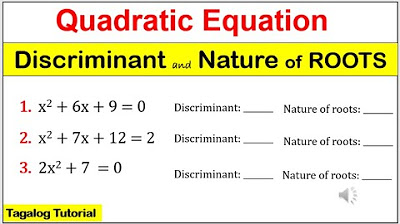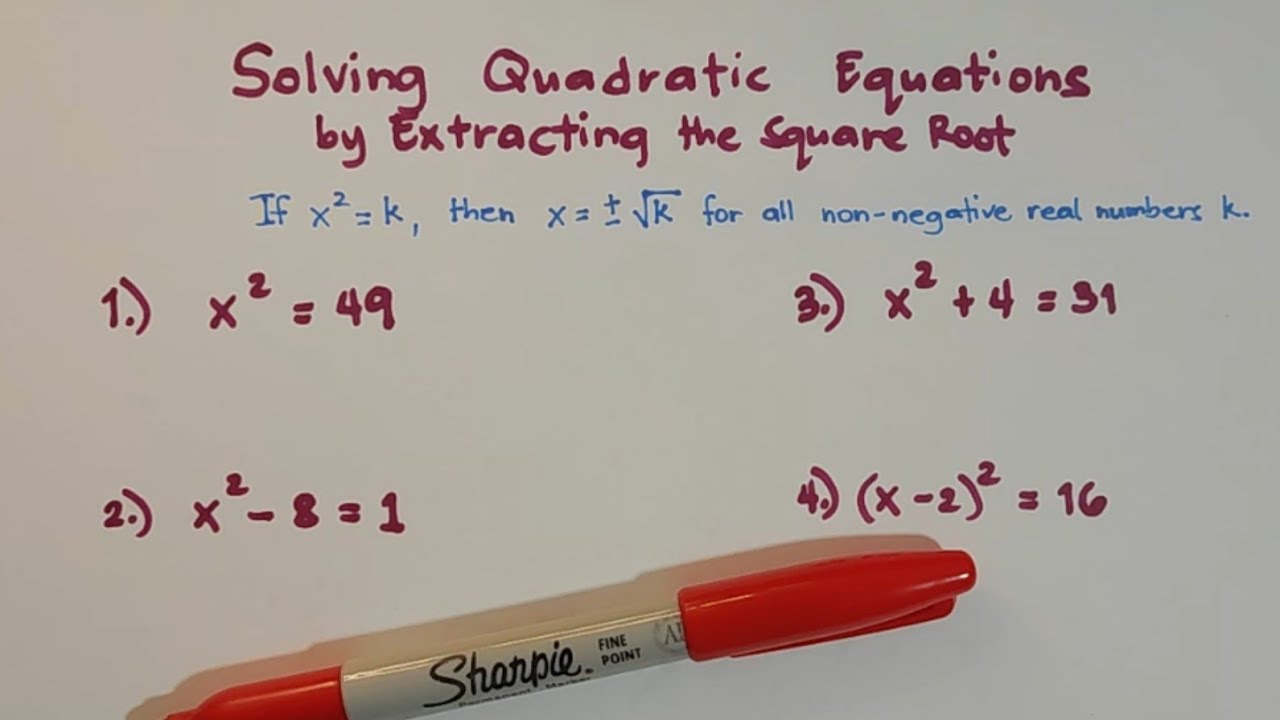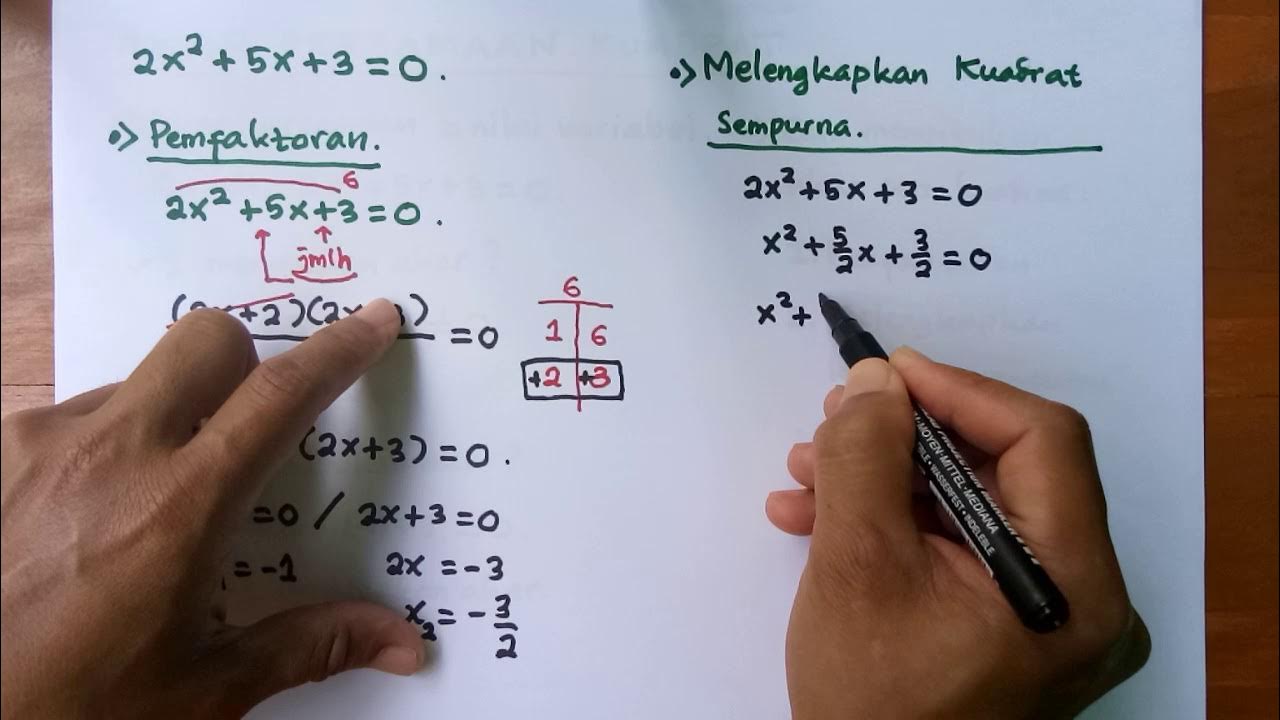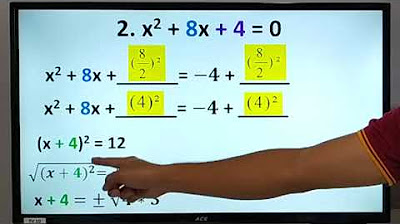Solving Quadratic Equations by Quadratic Formula | Not A Perfect Square | Part 2 |
Summary
TLDRIn this educational video, Teacher MJ explains how to find the roots of a quadratic equation using the quadratic formula, especially when the square root of the discriminant (b^2 - 4ac) is not a perfect square. The lesson includes step-by-step solutions for two examples, emphasizing the importance of identifying perfect squares and simplifying the equation to find the roots. The engaging presentation encourages students to practice and apply their knowledge in the comments section.
Takeaways
- 📚 The class is focused on finding roots of quadratic equations using the quadratic formula, especially when the square root is not a perfect square.
- 🔍 Part one of the video class covered basic examples with perfect square roots, and part two, which this script is based on, deals with non-perfect square roots.
- 📝 The quadratic formula is x = (-b ± √(b² - 4ac)) / (2a), and it's crucial to identify the values of a, b, and c from the equation before substitution.
- 🔢 The script provides step-by-step instructions on how to substitute values into the quadratic formula and simplify the expression, even when dealing with non-perfect squares.
- 😕 An example given is when b² - 4ac equals 20, which is not a perfect square, and the teacher explains how to handle such cases by finding two numbers that multiply to give the non-perfect square, one of which must be a perfect square.
- 📐 The concept of perfect squares is reviewed, explaining that they are numbers that result in a whole number when their square root is taken, such as 4, 9, 16, etc.
- 🤔 The script emphasizes the importance of simplifying the square root expression by separating it into a product of a perfect square and another number.
- 📝 Two detailed examples are worked through in the script, demonstrating the process of solving quadratic equations with non-perfect square roots.
- 👍 The teacher encourages students to try solving a given quadratic equation (x² + 2x - 1 = 0) and to post their answers in the comments to check their understanding.
- 📈 The script highlights the method of factoring out common terms from the square root expression to simplify the final answer.
- 👋 The class concludes with a reminder to like, share, and subscribe to the channel to help more students learn about solving quadratic equations.
Q & A
What is the main topic of the video class?
-The main topic of the video class is finding the roots of a quadratic equation using the quadratic formula, specifically when the square root in the solution is not a perfect square.
What is the quadratic formula?
-The quadratic formula is x = (-b ± √(b² - 4ac)) / (2a), used to find the roots of a quadratic equation ax² + bx + c = 0.
Why is it necessary to identify the values of a, b, and c before using the quadratic formula?
-Identifying the values of a, b, and c is necessary because these coefficients need to be substituted into the quadratic formula to solve for the variable x.
What does 'a' represent in the quadratic formula, and what is its default value if not explicitly stated?
-'a' in the quadratic formula represents the coefficient of the x² term. If no number is explicitly stated before x², the default value of 'a' is 1.
What is a perfect square, and why is it significant in solving quadratic equations?
-A perfect square is a number that can be expressed as the product of an integer with itself. It is significant in solving quadratic equations because if the square root in the solution is a perfect square, it simplifies the process of finding the roots.
How does the teacher handle the case when the square root in the quadratic formula is not a perfect square?
-The teacher explains that when the square root is not a perfect square, you should find two numbers that multiply to give the square root, where one is a perfect square and the other is not, and then simplify the expression accordingly.
What is the process for simplifying the square root of a non-perfect square number?
-The process involves finding two numbers that multiply to the given number, where one is a perfect square and the other is not. Then, you take the square root of the perfect square out of the radical and simplify the expression.
Why can't you combine terms with different radicals in the quadratic formula solution?
-You can't combine terms with different radicals because they have different radicands (the number under the radical sign). Only like radicals, which have the same radicand, can be combined.
What is the distributive property mentioned in the script, and how is it used to check the correctness of the solution?
-The distributive property states that a(b + c) = ab + ac. In the script, it is used to verify the correctness of the solution by multiplying the factored out term with the remaining terms to see if it results in the original expression.
How does the teacher encourage students to practice and check their understanding of the topic?
-The teacher encourages students to practice by attempting to solve a given quadratic equation x² + 2x - 1 = 0 and to post their answers in the comment section for review.
What is the purpose of the video's concluding remarks?
-The purpose of the concluding remarks is to remind students to engage with the material by liking, sharing, and subscribing to the channel, and to share the knowledge with friends and classmates to help more students understand the topic.
Outlines

This section is available to paid users only. Please upgrade to access this part.
Upgrade NowMindmap

This section is available to paid users only. Please upgrade to access this part.
Upgrade NowKeywords

This section is available to paid users only. Please upgrade to access this part.
Upgrade NowHighlights

This section is available to paid users only. Please upgrade to access this part.
Upgrade NowTranscripts

This section is available to paid users only. Please upgrade to access this part.
Upgrade NowBrowse More Related Video

MATH9 DISCRIMINANT and NATURE OF ROOTS of quadratic equation #math9 #discriminant #natureofroots

THE NATURE OF THE ROOTS OF A QUADRATIC EQUATION USING THE DISCRIMINANT || GRADE 9 MATHEMATICS Q1

Nature of Roots of Quadratic Equations

How to Solve Quadratic Equations by Extracting the Square Root? @MathTeacherGon

Mudah Dipahami 3 CARA MENENTUKAN AKAR PERSAMAAN KUADRAT

Math8 1G LV4 - Completing the Square and Quadratic Formula
5.0 / 5 (0 votes)